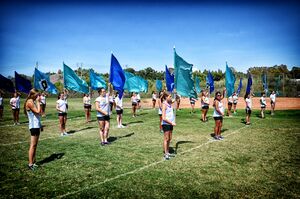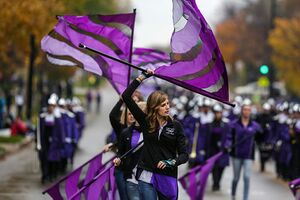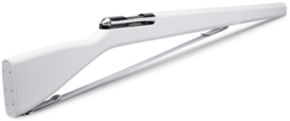Color guard
“Color Guard is a sport. No seriously, it really is! It's a sport, guys!! How dare anybody say otherwise?”
The color guard (also known as flag twirlers or pole dancers) is the most colorful section of the marching band. The corps is a notably less attractive but far more intelligent counterpart to cheerleaders, whom they absolutely hate. The main role of a color guard is to distract judges and to brutally maim band members who happen to be in the wrong place. The typical color guard comprises mostly girls but sometimes has one or two boys — normally flaming homosexuals. Color guard is internationally hailed as the "Sport of the Arts." In fact, it is neither.
Standard procedures
The guard competes at flag-twirling during the Fall and Winter. During the Fall season, color guards accompany a marching band to competitions and perform to out-of-tune music played by said band. Later, during the Winter, the guard performs a routine to their own music that is played through an out-of-tune stereo system.
Practices
Color guard is less popular than other activities such as Debate Society and dissecting fetal pigs. As a result, during practices color guards are usually crammed into the smallest rooms possible so that they will take the least amount of space, as more important practice spaces are reserved for more popular groups such as the cheerleaders or the chess team. This is where the guard tries to spin their weapons and flags without hitting too many people and expensive objects. Practices are typically an exciting affair during which guard members repeat the same routine hundreds of times. During rehearsals, the guard instructor will often say to do it "one more time," which normally means to do it 10 more times. When the coach says something looks "better," the routine is still not perfect. In such cases, the guard will continue to repeat the routine until it actually is perfect, or someone dies, whichever comes first. When guard members are injured during practice, they are often told to rub some ice or dirt on their wound and then to do it again. In the off-chance that a rifle or saber goes through a window or happens to impale the school's new speaker system during practice, the guard can usually just run away and leave it like it is. After all, nobody will blame the guard because barely anybody remembers that they exist. The school usually just blames it on the jocks anyway.
Competitions
When the marching band travels to a competition, guard members travel with them. It is at this time that the guard hastily attempts to apply make-up, hoping that their bus's bumpy suspension does not cause them to stab themselves in the eyes. Usually guards are quarantined on their own bus. This is due to the fact guard members often have glitter, which is an irreversible skin condition that is highly contagious to people who are not on guard. Once the guard arrives at their destination, they unload their equipment and begin to warm up. If anybody has forgotten their equipment at home or school, they are crucified on the spot by the color guard coach and the band director as a warning to others in the ensemble.
Once they are ready, the guard then follows the rest of the ensemble onto the competition field, where hundreds if not thousands of spectators are watching, eagerly waiting to judge them. During a performance, the guard performs their routine which may incorporate various of pieces of equipment, dance techniques and tosses high enough to threaten low-flying aircraft. In the spirit of High-School social-tensions, they do their best to show up other guards and make them eat their own feelings. However, no matter how hard the guard tries, there will always be at least one twirler who drops their equipment, hits themselves in the face, or hits a band member's instrument. Afterward, most guards will ask how they did so terribly during their performance when they did everything perfectly during practice. This is due to the fact that God himself causes guard girls to perform badly. At any given time, at least a hundred other guard girls in the stands are praying that the others do poorly so that they can win 1st place. Nobody admits that they do it, but everyone does. Even the coaches.
The off-season
During the spring and summer, color guards rest in order to heal the cuts, bruises and broken bones that they have accumulated throughout the season. In this time of rest, guard members may focus more on their school work, join other activities, or eat profusely. In the off-season, the schools also work to repair the numerous holes left in the walls and ceiling, wondering how they even got there in the first place.
Appearance
Color guards have stylish and tasteful uniforms that are worn during the competitive season. Most color guards wear scanty uniforms that cover as little skin as possible while still adhering to the school dress code. These uniforms can offer a flattering complement to any guard girl's physique, provided that she has the right body type, height, hair color, makeup, skin tone, and posture. However, more commonly, these uniforms simply look outright ugly.
Color guard uniforms also offer ample protection from a narrow variety elements. Exceptions include when the weather is too sunny, humid, cold, windy, rainy or even mild. Its as if the instructor forgot to consider all of these things through when they picked out the uniforms this year. If only they weren't so busy drinking away the memories of last season.
Equipment
There is a variety of equipment used by color guards around the world. All color guards typically use flags; however, color guards who possess more talent also incorporate other pieces of equipment into their routines, usually in an attempt to show off how much better they are.
Flags
Flags are the most common piece of color guard equipment. They are used throughout the world. Invented by the first color guard, flags have several feet of colorful fabric which can be used to steal attention from the band and those pesky cheerleaders. Those guard members who are ostentatious enough may seek even more attention by attempting to spin two or more flags at once.
Rifles
Rifles are the cornerstone of a color guard with any real claim to talent. Although being purely cosmetic in appearance, these wooden props are often mistaken by less informed individuals to be real guns. Despite their controversial nature, color guard rifles have remained a common piece of equipment used by guards around the world.
Airblades
On occasion, those darned liberals manage to get rifles banned from the band, for fear that somebody will go on a deadly rampage with their scary wooden gun. Ridiculous looking in appearance, airblades are a pansy leftist alternative to rifles.
Sabers
Sabers are another commonly used piece of color guard equipment. Despite their significantly different appearance, sabers function very similarly to rifles. However, they are arguably the most dangerous piece of equipment to use. After all, twirling a sword around in the air isn't exactly the most safe thing you could be doing with your spare time. Due to their inherently dangerous nature, only the most experienced twirlers should use sabers because of their high risk for decapitation and impalement.
Shields
Being common only on the Pacific Coast of the United States, few color guards are unfortunate enough to be subjected to spinning the prop known as "shields." Being about as visually appealing as an '80s fashion statement, most color guard members would rather choose death by saber impalement than to have to spin such horrendously ugly equipment. One can only imagine what kind of deranged mind saw fit to design something so awful.
Types of members
- Leader/captain – The leader type always knows best. When they are proven wrong, practices and performances grind to a halt until someone concedes that they are somewhat right, or have been right about something in the past.
- Slacker – The typical slacker is only in color guard because a) they have nothing to do, or b) they were forced to join by a parent, friend, or teacher.
- The Slut – One per squad. She denies it, but always sneaks off behind the buses with boys during competitions.
- The Bitch – One per squad. Nobody really likes her. She lends predictability to practices by always being in a bad mood. Who know a person could be on the rag four weeks out of four? Despite claiming to spin "like a bitch," she has no talent, apart from bitching.
- Kiss-up – These girls can't stand to see one hair out of place, one person out of step, or fall out of attention when it is clear that practice is over unless they are called out of it.
- Drama Queen – These love gossip, rumors, and cat-fights. They have the potential to entertain the public, whether or not their signature skills go on display.
- Energetically Horrible – An energetic girl, who nevertheless cannot twirl a flag without dropping it, usually makes the group for the sheer lack of anyone better.
- Normal – The rare normal color guard member is an automatic misfit. Usually a new member, they will not stay this way for long. Eventually, for better or for worse, they will naturally shift into one of the other categories.
- Male – Nine out of ten male color guard members play for the other team. In extremely rare occasions, a straight boy will join the color guard to get into the pants of a female guard member, or because he was too klutzy for the marching band.
Dangers
Those who are familiar with color guards know of the danger that they pose. This danger was most clearly exemplified during the Dover Massacre of '86. Every year, thousands of members of color guards, also marching bands, coaches and wandering judges are violently killed by flying flags, rifles and sabers. Most deaths occur through the inattention of the victim, but occasionally people fall prey to energetic but horrible guard members who never figured out how to control their flags.
The weather itself can also be a lethal problem for color guards, as sometimes Mother Nature can be a real bitch. As anybody who understands 3rd-grade earth science can tell you, lightning is a clear threat to color guards because it is strongly attracted to their giant metal poles. However, lighting is not a color guard's only natural threat. Even the wind itself is a mortal enemy to color guards. Just like how Hurricane Katrina struck New Orleans, a sudden gust of wind could hit an unsuspecting guard member at any time. A flag or rifle blown off-course by the wind can easily become a hurricane-like missile, leaving death, destruction and mass-looting in its wake. God have mercy on anybody who happens to get in its way.
Coaches
Coaches are people who used to be amazing at color guard. Fifteen years past, they could have caught a rifle behind their back while simultaneously doing a headstand and brushing their teeth. However, now in their declining years, they are little more coordinated than the average drunkard on a Friday night. This is particularly true if the coach actually happens to be an alcoholic. Despite now being too old to be able to casually participate in guard, they still cannot bring themselves to put their flag and rifle down for good. Given no other choice, they have resorted to coaching teenage girls how to spin around poles. While the rest of society would typically look down upon a 40 year old man spending so much time in the company of high-schoolers, most people find it permissible on the grounds that almost all color guard coaches are either women or really really flamboyant men.
Other color guards
The concept of color guard has been adapted to add color and pageantry to events other than high-school football games. A color guard accompanies many Heads of State to announce their arrival.
U.S. President Barack Obama often travels with a color guard. This guards his precious near-"black" color from threats from other colors, including assailants he would refer to as "typical white persons." Some of these could be racists.
| Featured version: 25 December 2015 | |
| This article has been featured on the main page. — You can vote for or nominate your favourite articles at Uncyclopedia:VFH. | |







